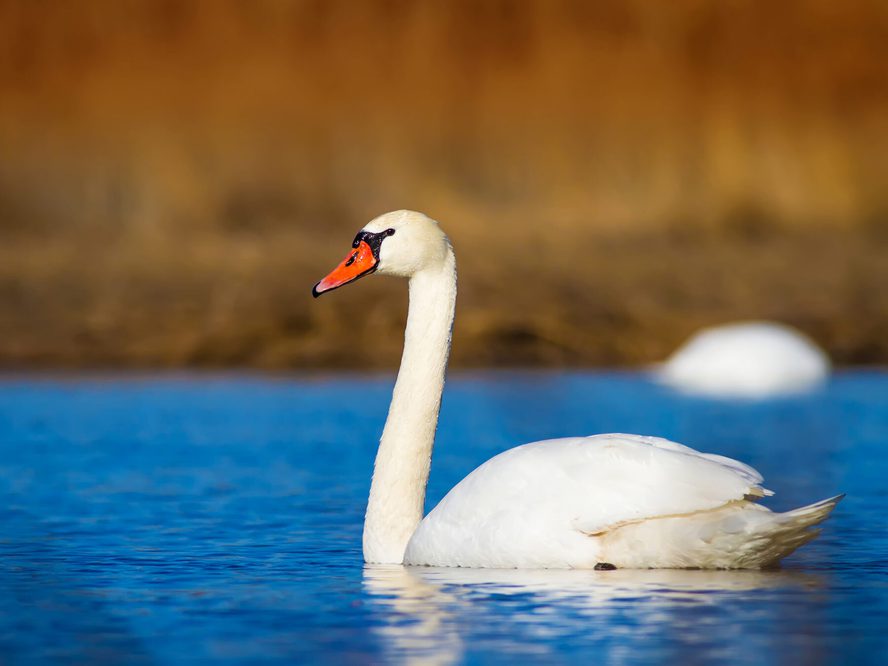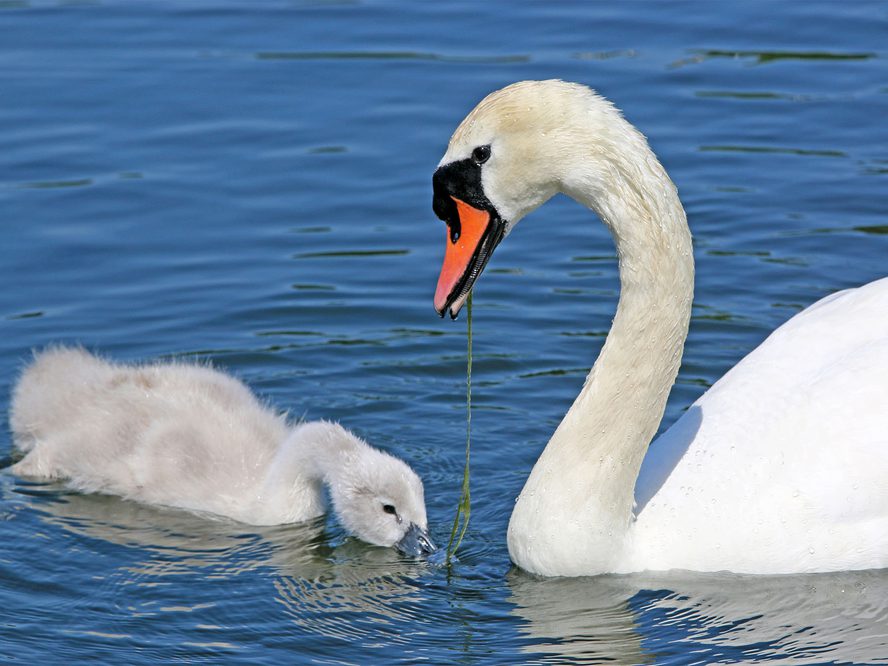Jump to Section
Why Are Swans Aggressive? (Can They Break Bones)
Last updated: 11 March 2024

Swans have a reputation for being vicious and aggressive towards other birds, animals and even humans. Anecdotal accounts exist about swans breaking people’s arms or killing pet dogs, and these serve as many a childhood warning to not get too close to a swan.
But is there any truth in these stories, or are they simply old wives’ tales? Do swans deserve this bad press as violent attackers? And if so, just why are swans aggressive? Read on to learn more.
Swans – particularly males – are fiercely protective over their nest site, cygnets and their mate. If they feel any of these are under threat, they hiss and flap their giant wings to warn off potential predators. If the threat persists, then they will strike using their powerful wings and bill.
Breeding swan pairs share a particularly strong bond, mating for life, and both partners play a crucial and protective role in the upbringing of young cygnets. Three species of swan – Whooper, Bewick’s, and Mute swans – are especially known for showing signs of aggression when their nest site is threatened, as well as when competing for food.
Territorial defense of a nest and cygnets is marked with loud hissing and can quickly escalate into a full-scale violent attack, either on land or in water if the swan perceives there is a real risk of danger to its young.
Unprovoked attacks by swans are rare, especially outside of breeding season, but caution should always be taken not to cause distress to any wild birds or animals, and approaching a wild swan is not recommended under any circumstances.
Read on to find out more about how swans protect themselves and how much physical damage an angry swan might be capable of inflicting if it feels under serious threat.

Swans are mainly aggressive when near their nests, young and partners
How do swans protect themselves?
To protect themselves and their young, swans initially give a warning display, indicating that unless an “intruder” or potential predator backs off, an attack is imminent. This involves loud hissing, wing flapping, stretching of the neck upwards and spreading wings wide, in a posture known as busking.
If this intimidating territorial display is not enough to convince the threat to retreat, a full-scale attack may follow, both in the water or on land.
On water, a swan will tuck its head under its wing, and propel itself forward through the water, feet first towards the source of threat, which is usually another bird.
The busking posture is also seen in swan attacks that take place on land. The swan opens its wings, holding them as wide and high as possible, and, with its head and neck downwards, runs towards the threat, while flapping its wings and hissing noisily.
Swans in attack mode will strike at the source of the threat, using their giant wings, which are adapted for combat with thickened bony spurs and spikes. This will be accompanied by biting or pulling with their powerful beak, although as they do not have teeth, any harm from a swan bite will not be extensive.

A hissing Mute Swan mother protecting her young
When do swans get aggressive?
Swans are at their most aggressive during the breeding season, and it is best to avoid getting too close to these birds or their nesting site between late April and June. Swans attack in response to threats to their mate, young, or nest.
If the threat does not recede after an initial warning display, it is not uncommon for a full-scale attack in defense of their family to follow.
Hungry swans may display aggressive behavior if food sources are in short supply and they need to compete with other birds for food.

Swan with cygnets on the water
Are swans aggressive to humans?
In theory, swans will not act aggressively towards humans unless they feel that their nest site and young are in danger. Humans who are not approaching or antagonizing a swan should not have anything to worry about.
However, news stories exist that back up the claim that swans can behave aggressively towards humans, even when they are not actively approaching or disturbing their nesting site.
One tragic story that made the news was an attack on a kayaker on a Chicago pond in 2012. A swan rushed at his kayak, knocking him into the water, and then prevented him from swimming to the shore, resulting in his death by drowning.
Rowers and other river users on the River Cam reported repeated attacks by a violent swan in 2014, even appealing to the Queen of England to approve its relocation to a different spot.
Occasionally, swans may act in an aggressive, intimidating, or forceful way when seeking food from visitors feeding waterfowl at lakes, particularly if the person is ‘playing’ with the food or taunting or teasing the swan.

Whooper Swan foraging in the grass for food
What do you do if a swan attacks you?
If you find yourself in the unfortunate and potentially terrifying situation of being attacked by a swan, there are a few suggestions that may help you to escape.
It is not advised to turn your back on an angry or aggressive swan. Doing so may show the swan that you did pose a threat, and they will continue to chase you off.
The same applies to running; tempting as it may be to sprint off in search of safety, swan behavior experts recommend continuing to face the swan and backing away slowly, while making yourself appear as big and intimidating as possible, by opening your arms wide as you retreat.

Close up of an angry mute swan
Can a swan break your arm with its neck?
Many adults remain wary even once their childhood days are long past, due to being told cautionary tales about fearless individuals who strayed too close to angry swans and were violently pursued, suffering broken bones in the attack that ensued.
In reality, swans are not physically built in such a way to attack with the necessary force to inflict injuries as drastic as broken bones.
Swans have hollow bones, and are not as physically strong or forceful as you may think. They weigh 11 kg (24 lb), which in bird-terms is quite impressive, but no match for an adult human.
Children should be kept at a safe distance to avoid unintentionally aggravating a protective swan, and dogs should be kept on leads.
Any injuries such as broken bones are more likely to be sustained by falling while running away from a swan. Bruising may occur from wing strikes, but generally speaking, a swan’s wings or neck are not strong enough to inflict more serious levels of injury on an adult.
Reports do exist of uncontrolled dogs being attacked and killed by protective swans during breeding season, but in balance, other reports also exist of dogs killing swans in unprovoked attacks.

It's a common misconception that a swan can break your arm, when in fact, they don't have the ability to do so
Do swans fight to the death?
Male swans have been observed to fight each other to the death, when it comes to the matter of defending their territories during breeding season. If a particularly violent clash occurs between two male swans (known as cobs), one may eventually back down and admit defeat, although it is not unheard of for such a battle to end in death.
Reports of “killer swans” periodically come to the attention of the media, including a Mute swan in Wales, dubbed Mr Nasty, that claimed the lives of at least ten other swans.

A pair of male Whooper Swans fighting over territory in spring
Are swans more aggressive than geese?
Both swans and geese demonstrate aggressive behavior towards other birds and towards humans, particularly during breeding season. While geese are noisier aggressors, swans intimidate with their sheer size, and have a fearsome reputation for inflicting damage on anything they consider a threat to their mate or young.
Research by the WWT (Wildfowl & Wetlands Trust) concluded that neither geese or swans were in fact any more aggressive than any other bird species, although both birds are highly protective of their young and will attack if they feel their nesting site is in danger.








